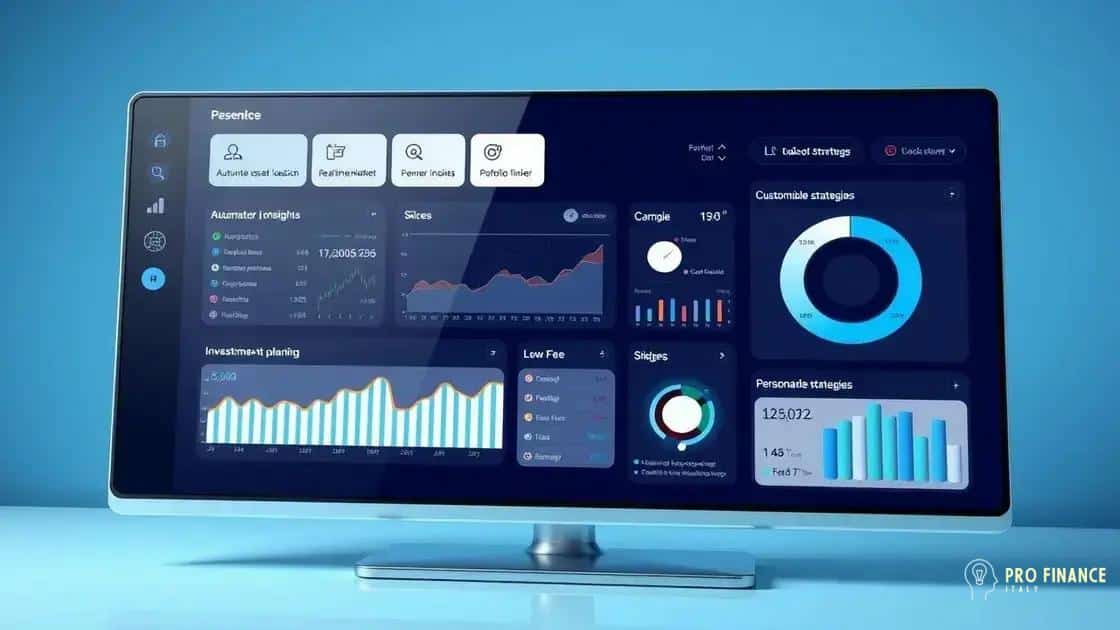The rise of robo-advisors in wealth management

The rise of robo-advisors in wealth management provides cost-effective, accessible, and personalized investment solutions that leverage technology to optimize financial planning for a wider audience.
The rise of robo-advisors in wealth management is reshaping how individuals approach investing. Have you considered how these digital platforms might simplify your financial planning? Let’s delve into this evolving trend.
Understanding robo-advisors
Understanding robo-advisors is essential for anyone interested in modern wealth management. These digital platforms are designed to simplify the investment process for people of all financial backgrounds.
What are Robo-Advisors?
Robo-advisors are online services that provide automated financial planning with little to no human intervention. They use algorithms to create and manage a diversified investment portfolio for users, based on their individual risk tolerance and investment goals.
Key Features
- Automatic portfolio management
- Personalized investment strategies
- Low fees compared to traditional advisors
- Accessibility for all investors
Investing with robo-advisors is straightforward. Users typically fill out a questionnaire regarding their financial situation, investing preferences, and risk tolerance. Based on this information, the robo-advisor can create a tailored investment strategy. Over time, as market conditions change, these platforms automatically rebalance the portfolios to maintain the desired asset allocation.
A major advantage of using robo-advisors is their cost-effectiveness. Many offer low fees since they minimize the human labor involved in investment management. This approach helps investors keep more of their returns. Additionally, robo-advisors can be accessed 24/7, allowing users to manage their investments at their convenience.
Benefits of Robo-Advisors
- Time-saving and efficient
- Educational resources for beginner investors
- Transparent fee structures
- Customizable investment options
As you explore the world of robo-advisors, it’s important to consider their limitations too. While they are excellent for many, some investors may prefer the personalized service that comes with traditional financial advisors. Understanding these nuances will help you make informed decisions about your wealth management strategies.
Key features of robo-advisors

Key features of robo-advisors play a crucial role in their appeal and functionality. These platforms are designed to make investing easier and more accessible for everyone, regardless of their financial expertise.
Automated Portfolio Management
One of the standout features is their automated portfolio management. This means that once users set their investment preferences, the robo-advisor takes care of the rest. This service automatically adjusts investments to align with market conditions and individual goals.
Low Fees
Another significant benefit is the low fees associated with robo-advising services. Unlike traditional financial advisors, who may charge high commissions, robo-advisors typically have much lower management fees. This cost savings can translate to greater returns for investors in the long run.
- Minimal human intervention lowers costs.
- Transparent fee structures are easy to understand.
- No hidden charges, making budgeting easier.
Accessibility is also a key feature of robo-advisors. They often allow clients to start investing with relatively small amounts of money—this encourages new investors to participate. Users can usually set up accounts easily through user-friendly platforms or mobile apps.
Personalized Investment Strategies
- Investment strategies tailored to individual risk tolerance.
- Portfolio recommendations based on personal goals.
- Customizable asset allocation options.
This personalization makes robo-advisors a great choice for those who may be unsure about how to begin investing. Users receive guidelines that suit their financial situations and preferences without feeling lost in a complicated process.
Overall, these key features reflect how robo-advisors are reshaping the investment landscape. By delivering efficient, cost-effective, and personalized services, they meet the needs of today’s investors in a dynamic and accessible way.
Advantages of using robo-advisors
There are many advantages of using robo-advisors for wealth management. These digital platforms offer unique benefits that make investing more accessible and effective for many individuals.
Cost-Effective Solutions
One of the most significant advantages is their cost-effectiveness. Robo-advisors typically feature lower fees than traditional financial advisors. This setup helps investors save money while growing their portfolios.
- Reduced management fees compared to human advisors.
- No hidden fees, ensuring clarity in costs.
- More of your money goes toward investments.
Many robo-advisors also have low minimum balance requirements. This accessibility allows anyone to begin investing, even with limited funds. You don’t need a large amount of money to start building your wealth.
User-Friendly Experience
Another advantage is the user-friendly experience. These platforms often have intuitive designs, making it easy to navigate. Users can monitor their investments, adjust their profiles, and make informed decisions without needing advanced financial knowledge.
The automation in robo-advisors provides peace of mind. With automatic rebalancing, your portfolio stays aligned with your investment goals, responding to market changes without the need for constant management. This feature is valuable for busy individuals who may not have time to frequently check their investments.
Personalized Investment Strategies
- Customized portfolio recommendations based on personal risk tolerance.
- Asset allocations tailored to individual financial goals.
- Flexible options that adapt to life changes.
Moreover, robo-advisors often provide access to various investment options. From stocks to bonds and ETFs, users enjoy a diversified portfolio that can enhance returns over time. This range of choices empowers users to align their investments with their beliefs and objectives.
Overall, the advantages of using robo-advisors reveal how they can support modern investors. By providing cost savings, ease of use, and personalized solutions, they are a valuable tool in today’s financial landscape.
How robo-advisors compare to traditional advisors
Understanding how robo-advisors compare to traditional advisors is essential for anyone considering their investment options. While both provide valuable services, there are key differences that potential investors should know.
Cost Comparison
One major difference is the cost structure. Robo-advisors typically charge much lower fees than traditional financial advisors. This is because they rely on automated systems rather than needing teams of human advisors. Clients can save a significant amount of money in management fees, allowing more of their investment to work for them.
- Robo-advisors often charge around 0.25% to 0.50% of assets under management.
- Traditional advisors can charge 1% or more, which can eat into returns over time.
- Lower fees mean higher long-term investment gains.
Additionally, traditional advisors may have high minimum investment requirements, while robo-advisors allow anyone to start with a small amount, making investing more accessible.
Personalized Services
When it comes to personal service, traditional advisors offer a tailored approach. They provide one-on-one consultations, which can help clients feel more connected to their investment strategies. This personal touch allows traditional advisors to consider personal circumstances more deeply. In contrast, robo-advisors operate primarily on algorithms, which deliver personalized investment plans based on predefined inputs, yet lack the human touch.
Consequently, while robo-advisors are effective for many investors, those seeking more comprehensive financial planning, such as estate planning or tax strategies, might prefer working with traditional advisors. Traditional advisors can offer a wider range of advice that goes beyond just investments, encompassing tax efficiency, retirement planning, and more.
Investment Approach
- Robo-advisors often use a passive investment approach, focusing on index funds.
- Traditional advisors may take a more active role in managing investments.
- Some investors prefer the hands-off approach of robo-advisors.
Many robo-advisors focus on low-cost, exchange-traded funds (ETFs) and aim to replicate market returns, which can appeal to those who want simplicity in their investment strategy. Traditional advisors may be more likely to engage in active trading, potentially leading to higher risks and rewards.
Overall, understanding how robo-advisors compare to traditional advisors helps investors make informed decisions. Each option has its strengths, and recognizing these differences is key to selecting the right path for one’s financial future.
Future trends in robo-advisory services
The future trends in robo-advisory services are shaping the landscape of wealth management. As technology evolves, so do the options available to investors.
Integration of Artificial Intelligence
One major trend is the increasing use of artificial intelligence (AI) in robo-advisory platforms. AI can enhance service personalization, allowing these platforms to analyze user data more effectively and create tailored investment strategies. This shift promises to improve user experience and investment outcomes.
- Better risk assessment through data analysis.
- Enhanced customer support via chatbots and virtual advisors.
- More accurate predictions of market trends.
With AI, robo-advisors can help clients adapt quickly to changing market conditions, making investment adjustments automatically.
Environmental, Social, and Governance (ESG) Investments
Another trend is the growing focus on ESG investments. Many investors are now looking for ways to align their portfolios with their values. In response, robo-advisory services are starting to offer socially responsible investment options that consider environmental impact and social responsibility.
- Increased demand for sustainable investing options.
- Integration of ESG criteria into investment algorithms.
- More educational resources about sustainable investing.
These features cater to a new generation of investors who are conscious of the impact their investments have on the world.
Improved Accessibility and User Experience
Future robo-advisors are likely to improve accessibility for users. Enhanced user interfaces, mobile applications, and educational content will make it easier for individuals to manage their finances. More intuitive platforms will attract a broader audience, including younger investors who seek convenience and flexibility.
Additionally, advancements in data security will address concerns about privacy and protection. As these features improve, investors will feel more confident using robo-advisors for their financial planning.
Hybrid Models
- Combining technology with human support.
- Ability to consult with human advisors when needed.
- Meeting the needs of different types of investors.
Hybrid models that combine robo-advisors with human financial advisors are emerging. This approach offers the best of both worlds, allowing clients to benefit from automated services while still having access to human expertise when necessary.
Overall, the future of robo-advisory services looks promising. With advances in technology, sustainability efforts, and a focus on user experience, these services are set to transform how people manage their investments.
In conclusion, the rise of robo-advisors in wealth management offers investors a variety of benefits. From lower fees and accessibility to advanced technology and personalized investment strategies, these platforms are transforming how people manage their money. As technology continues to advance, it’s likely that robo-advisors will incorporate more features, making investing even easier for everyone. Whether you’re a beginner or an experienced investor, understanding these changes will help you make informed decisions about your financial future.
FAQ – Frequently Asked Questions about Robo-Advisors
What are robo-advisors?
Robo-advisors are online platforms that provide automated financial planning and investment management with minimal human intervention.
How do robo-advisors lower investment costs?
They charge lower fees compared to traditional financial advisors due to automated systems that reduce the need for personal management.
Can I start investing with a small amount using robo-advisors?
Yes, many robo-advisors allow you to begin investing with low minimum balance requirements, making investing accessible to more people.
What should I consider when choosing a robo-advisor?
Consider fees, investment options, ease of use, customer support, and whether they offer personalized investment strategies.





